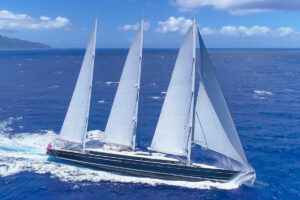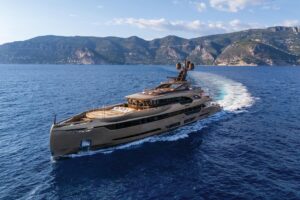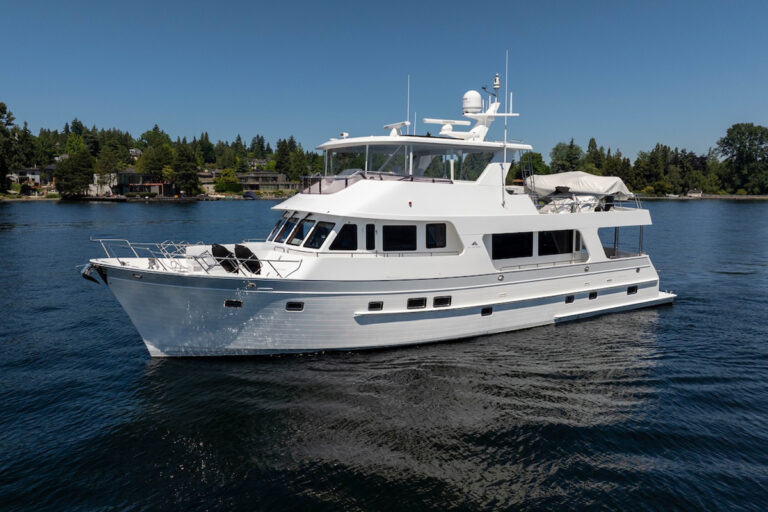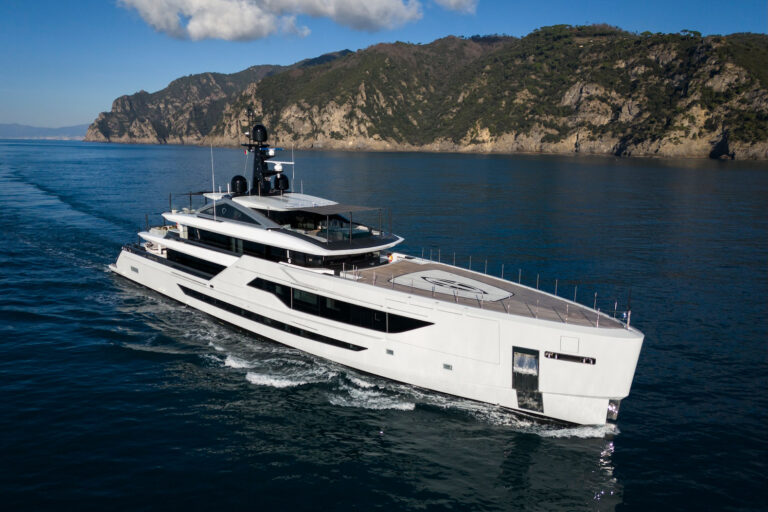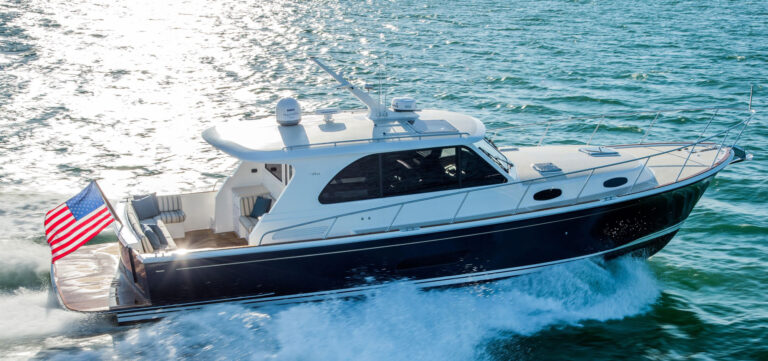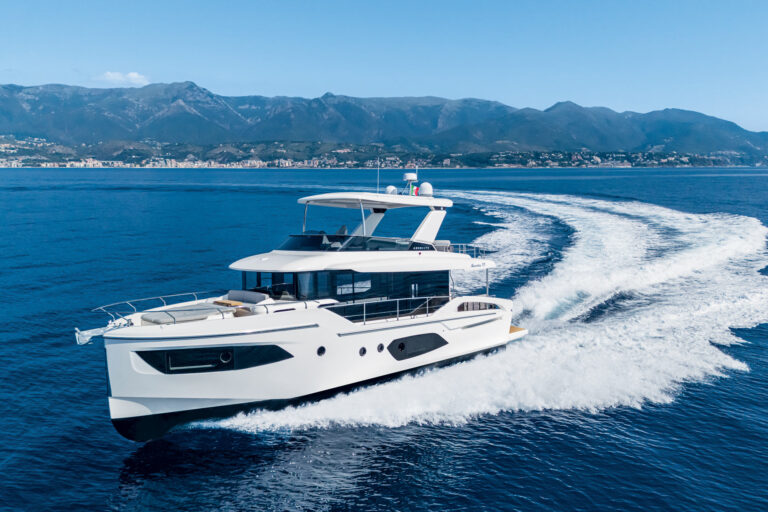South Georgia Island-breeding ground of the Antarctic, a high-latitude Eden, the geological spectacle that led James Cook to believe he had discovered the great southern continent. It was the site of the whaling industry in the Southern Ocean for much of the 20th century, and is the final resting place and center of drama for the life of Sir Ernest Shackleton.
Surrounded by ice and the most famous and dangerous waters in the world, South Georgia Island to me represents the pinnacle destination on Earth. With this in mind, I set my sights on sailing to her shores, but nearly 10 years of reading, planning, dreaming and voyaging would pass before we cast off.
Next came Shaman. Her design and construction became the cornerstone of the adventure. During her gestation, my vision of sailing to South Georgia Island became the tool I used to inspire the designer, project manager, boatbuilder, sail maker and spar builder as each joined me in creating this 88-foot sailing yacht. Everything about Shaman was created with this mission in mind. We launched her in 1997, and every voyage aboard her-past many glaciers, through many storms from Spitzbergen to Stewart Island, New Zealand-built my confidence for the passage to South Georgia.
Preparation: The Management of Fear
To dream and consider is not the same as to act. Setting out on an expedition to South Georgia Island is daunting-the water temperature is 30 degrees Fahrenheit, winds often exceed 50 knots, and waves frequently reach the height of 50 feet.
We expected to hike on land that features elevation changes of 2,000 to 3,000 feet in a day’s trek. We could reach elevations of nearly 10,000 feet less than three miles from shore. Animals, in this case fur seals, can bite, leaving a dangerous infection, and South Georgia does not have a hospital.
Fear will always be present when risk and danger are real, yet excessive fear constricts the scope of an adventure-limiting or choking off action. Much pleasure, excitement and achievement are lost paying excessive homage to fear. Though fear cannot be anesthetized, more dangerous still is to deny its existence. Fear winks at denial and tempts one to take excessive risk while he pretends no danger is present.
I believe that the central focus of expedition sailing is fear management. Are the boat, the equipment, the team, and the preparation thorough enough to adequately manage the risk of an expedition? Is the culture built among the crew strong and able to cultivate trust and support? How does this group work together to roll back the envelope of the fear that limits action-roll back, but not eliminate, fear to get the most from the experience?
The Team
I selected a team of nine people, including myself. Raymond Wroe Street and Kim Broas had been aboard Shaman for four years. They knew her inside out and thoroughly handled the mechanical and logistics preparations. Raymond’s brother, Grant, and Simon Laight were the athletes, and Grant was an experienced outdoorsman, hiker and climber.
The reputation of the Southern Ocean suggested to me that I needed seasoned sailors, some of whom knew how to steer in heavy seas, particularly downwind. An 88-foot light-displacement sloop, such as Shaman, is capable of reaching speeds of 20 knots, or more, in the conditions that prevail in the Roaring Forties. A mistake aboard a 100,000 lb. yacht hurtling through confused seas at that speed can be costly.
Erik Soper, a Whitbread Race veteran, had a strong, indelible spirit. He came to be known as Crean after the member of Shackleton’s crew Tom Crean, who was at Shackleton’s side throughout his voyage. Every job was his job in his mind. Erik was testament to us all that we could do more.
Onne van der Wal was our photographer and a Whitbread veteran, as well. He is a fine seaman and a veteran of the Southern Ocean. His skill as a sailor added to our confidence, and his craft preserved our memories so we could share them forevermore.
Peter Wilson was the project manager in the building of Shaman, and a seasoned seaman. He was formerly a captain and ocean racer. His presence at every stage of the build comforted me on the voyage, and I was delighted that he had the chance to experience firsthand that which he had helped create.
We also needed knowledge of the island, its harbors and its hazards. We were very fortunate to find a guide in Eef Willems. Originally from the Netherlands, Eef had been to South Georgia Island (SGI) several times, taking part in surveys of the island’s animal population, and had knowledge of its geology, animal life, plus wind and shelter characteristics around the entire circumference. Eef also had a very loving, enthusiastic and encouraging way about her that was vital to her leadership. We could feel that she wanted us to stretch to see what she knew was waiting for us, and that she cared about our safety.
Departure
We left Ushuaia, Argentina, on February 7 and traveled briefly to Puerto Williams, Chile. Then we sailed out into the ocean, where light winds greeted us, and eventually built to 20-25 knots off the port beam. We clipped along at 10-12 knots, at last on our way. Eef briefed us on what we could expect during the 1,300-mile trip to SGI. Cool temperatures prevailed, and we reviewed the safety procedures. Everyone on deck had to wear a safety harness and clip into a tether. In addition to that, everyone on deck wore a personal EPIRB and a life jacket.
Our trip was largely uneventful for 800 miles. Eef continued to tell stories about the island, which whetted our appetite and spurred us on. As we got closer, icebergs, 200 to 400 feet high, began to appear on the horizon. We were able to see the ice on radar, and during the daylight hours (about 19 hours of the day in the Antarctic summer), we could spot them in the distance. As the ice masses grew more numerous, Eef requested that we slow the boat to 5 knots, or slower, during the hours of darkness and station a crewman on the bow during daylight hours as a lookout for ice.
Anticipation of reaching the island clearly opposed this prudent go-slow strategy. Yet Eef had cultivated the confidence in her leadership, and even racehorses, such as myself, “took a patience pill and supported this safer approach.
Approach and First Landing
On a slightly hazy and overcast day, we sailed up to the northwest corner of the island and moved toward landing at Right Whale Bay. As we approached the anchorage, two things were apparent. First, the symphony of animal cries was worthy of a Steven Spielberg movie. Fur seals, elephant seals and penguins provided a continuous soundtrack that was more densely filled than I ever imagined. As dusk approached, we could make out the outlines of the myriad of animals at play on the beach.
Our sense of smell told us that this place differed from any most of us had ever visited. Not even the monkey house at the San Diego Zoo could compare with this notification that animal life was abundant. In my journal of the day I wrote:
Animal cries were everywhere. Captain Raymond looked a bit stunned, and I inquired as to his concern. “Rob this is the most amazing place I have ever been. It will probably be the most amazing place I will ever go, he replied. Awe was in every pair of eyes I explored. The excitement of the romantic quest to the land of Shackleton had given way to that which was before our eyes and in our ears.
Grytviken
The center of the whaling industry in the Southern Ocean was Grytviken. It is also the site of Sir Ernest Shackleton’s grave, the South Georgia Island Museum and the British Antarctic Survey station. Here we checked in and got acquainted with the 20, or so, inhabitants of the island. The remains of the whaling station and the museum are wonderful, as are the couple who run it, Tim and Pauline Carr. We explored the old abandoned whaling station with Pauline as guide, and Onne documented the remains. This was all the more important, as we learned that the British government was going to tear down these remains over the next couple of years.
Ernest Henry Shackleton
How ironic, I thought, that the place we set out to see as a pinnacle adventure was the same place that Ernest Shackleton sailed to in order to return to safety.
Many times, close examination deflates the mystique of a heroic figure. In this case, though, the farther we went in exploring the life and experience of Shackleton, the more powerful his heroism became. Shackleton is a man who once turned back when he almost surely could have been first to the South Pole, because two in his party would perish. He had the strength and the sense to place the value of humanity above the temptation of his personal record of achievement, and in the end is all the more heroic and immortal for the choices he made.
To visit the beach where he landed after his 800-mile trip from Elephant Island to South Georgia Island and to replicate the first and third parts of his hike (one cannot cross the glaciers in the middle of summer on South Georgia) across the island was to see and feel how dismaying the task must have been to the six men who came here in a 22-foot boat and for the three of them who climbed across 10,000 feet of elevation to safety on the far side of the island as winter approached. It awed us to stand on the mountains and look down at Stromness and imagine how the three trekkers felt when they could see they would reach the protection of fellow men again.
Perhaps even more remarkable was that Shackleton, after a very short rest, returned to the windward side of the island and then, after four attempts to pierce the pack ice, continued to Elephant Island and rescued all of his team. Every one of them was alive.
Shackleton died a few years later aboard ship while docked at Grytviken. On February 15, the 129th anniversary of Shackleton’s birth, we visited his grave on South Georgia and celebrated with a cake inscribed with the Shackleton family motto, “By Endurance We Conquer. Inscribed on the back of the gravestone is the following: “I held that a man should strive to the uttermost for his life’s set prize.-Robert Browning.
Albatross Island
We spent two days on Albatross Island playing with the nesting/mating wandering albatross. This last stop was the most moving of experiences for me. I stood in the grass, manning a digital still camera, a video camera and a tripod, and watched birds perform their mating dance, and fly overhead, their 11-foot wingspan ripping the winds as they soared around the cliffs. Late in the day, just as the sun was setting, the activity was frenetic. Onne was taking photos of the birds from no more than five feet away. At one point, two birds, which had been engaged in the vivid mating dance, came up next to me. One of them nibbled on my glove. It then turned and sat down not 18 inches from my right thigh. I took off my glove and sat there petting its beautiful white-feathered back. Tears flowed down my cheeks. Tenderness and wonder filled my spirit.
After returning to Shaman I wrote in my journal: I touched a bird and something in me was touched. At that moment, standing with Simon, Eef, Peter and Onne I could feel that I have completed what I came here to do. I cannot tell you what it is that I came here to do. But I know I have completed it. I am ready to come home. I do not entirely know why I built this boat. I do not know why South Georgia Island was my ultimate destination from the beginning. When we took off, I expected it to be stimulating and, at times, stunning. But I did not know all of what I wanted to accomplish. I did not know either, early on, what would free my mind to set sail away from here feeling satiated and satisfied. I have a feeling that we have taken the time and done this trip in a way that the British call “proper. We have seen a lot, and the experience of this island has been significantly more powerful than I had expected. Even with high expectations, I do not know now why this moment with the wandering albatross completed my satisfaction, and I do not even know what it is that constitutes completeness. I just feel it. I can come home now.
Heading Home
I was ready to go home. The magnetic pull of family, business, and friendships grew increasingly strong. Our weather forecaster, Lee, suggested to us that the window was closing as fall approached the Southern Hemisphere. We chose as best we could, but we knew as we set out that we would have to push through one storm system to get to Montevideo, Uruguay.
Snow was falling on the mountains as we left, and winds were moderate. Dolphins and albatross took turns as escorts, leading our parade toward home. Winds and seas continued to build and move forward, forcing us to shorten sail. Over the next 48 hours, we saw what the Furious Fifties and Roaring Forties are famous for. I recalled Shackleton’s story about thinking he saw light in the dead of the night only to find that it was the white crest of a wave. I experienced a similar illusion when a crest crashed across the horizon abeam to the west.
It was our final test. Four times, waves crashing into the steering cockpit knocked the helmsman off of his feet. The power of the Southern Ocean lived up to the tales, and I knew we did not see the worst of its wrath. Shaman was strong and the crew was capable, but we were aware that the sea could take us if it wanted to.
As the storm receded and the wind backed into the west, Shaman surfed down the seas, hitting more than 20 knots on several occasions. We proceeded north and out of the 40s, the conditions eased and the temperatures warmed enough to let us step out of our woolies and wet gear. A beautiful sunrise and Van Morrison on the stereo brought relief to everyone.
That evening, we landed in Montevideo and tied stern to the dock. Peter Wilson had gone ashore in the dinghy, and when he fastened the stern line, he cried “made for all of us to hear. Shaman had safely completed that which she had been designed to do. It was the trip of a lifetime. I am so grateful.
Rob Johnson is a Wall Street business man and avid sailor.


